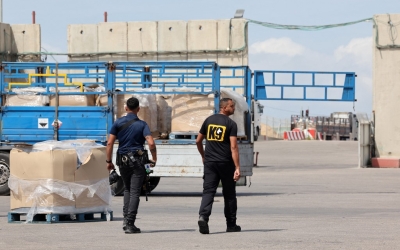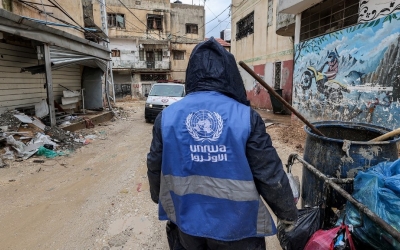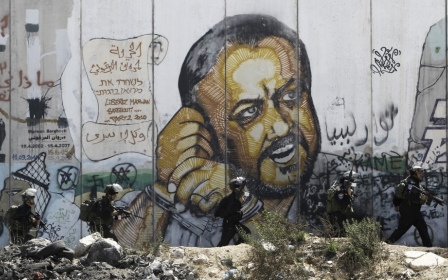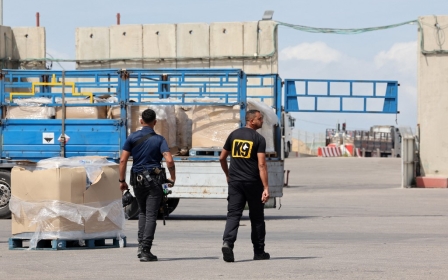Famine in Gaza expected 'anytime' from now, says UN agency
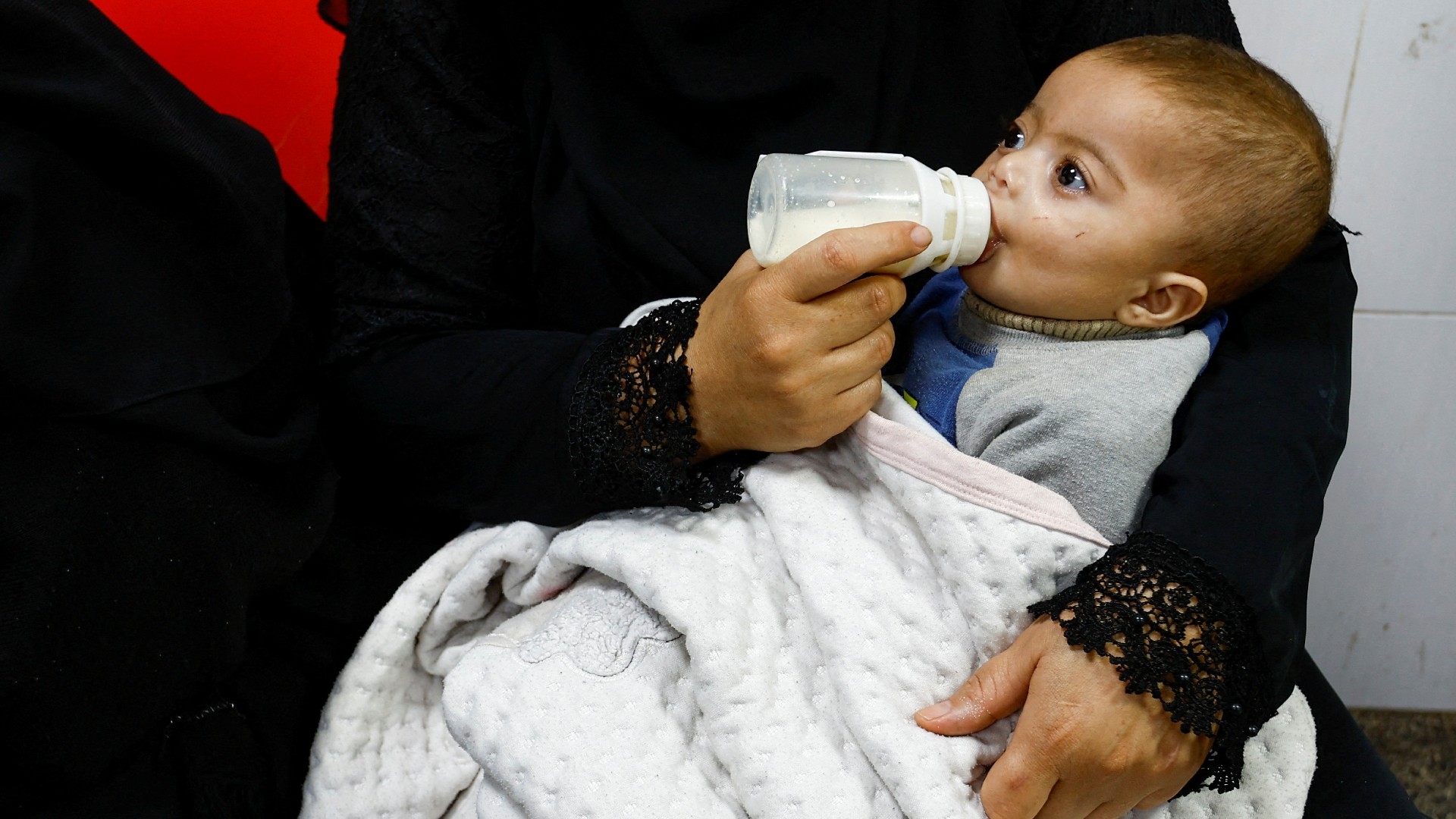
The UN Food and Agriculture Organisation (FAO) said on Monday that famine is expected in northern Gaza anytime from now.
"Famine is projected to occur anytime between now and May 2024 in the northern governorates," the UN agency said, citing a new analysis by the Integrated Food Security Phase Classification (IPC) on Gaza.
According to the IPC report, the entire population of Gaza, estimated to be around 2.3 million, is enduring "acute" food insecurity, while half the population suffers from a greater level of food insecurity classified as "catastrophic".
The UN and other aid agencies have warned that Gaza is on the brink of famine due to Israel's prevention of the entry of life-saving aid through the enclave's land crossings.
The EU's foreign policy chief, Joseph Borrell, said on Monday that Israel was provoking starvation and using starvation as a weapon of war, adding that the humanitarian crisis is "man-made".
New MEE newsletter: Jerusalem Dispatch
Sign up to get the latest insights and analysis on Israel-Palestine, alongside Turkey Unpacked and other MEE newsletters
"The support is there waiting. Trucks are stopped, people are dying while the land crossings are artificially closed," Joseph Borrel said on Monday.
"We send parachutes to a place that is one hour by car from the next airport. Why do we not send it to the airport? Because they do not let it."
The UN's FAO said the IPC analysis showed that food insecurity in Gaza has "deepened and widened" since the latest analysis conducted in December.
An estimated 79 percent of the population in Gaza fell into "catastrophic levels of hunger" from mid-February to mid-March, and 92 percent is expected to do so between now and July, the FAO said, based on the IPC analysis.
"If no steps are taken to cease hostilities and to provide more humanitarian access, famine is imminent," said FAO deputy director-general Beth Bechdol.
"It could already be occurring. Immediate access is needed to facilitate delivery of urgent and critical assistance at scale."
Worsening hunger
The review follows another IPC report in December that found that 17 percent of Gaza's population was on the verge of famine, and warned that there was a risk of famine by the end of May 2024 if the Israeli onslaught continued.
The latest report reveals a sharp increase on these figures, with 30 percent of households in Gaza experiencing "catastrophic" levels of hunger, the most severe stage on the IPC's five-phase metric for measuring famine. The threshold for famine is crossed when food security, nutrition and mortality conditions affect at least 20 percent of the population.
'Eighty percent of the children have infectious diseases; 70 percent have diarrhoea. They don't have enough food...it's a perfect mix for malnutrition to have devastating impacts'
- Vincent Stehli, Action Against Hunger
Over half of the population who are on the verge of famine are in the northern governorates, where humanitarian access is extremely limited.
According to the latest analysis, since the December report, the conditions to prevent famine had not been met, with continued conflict and restricted access to the northern governorates for humanitarian organisations and aid trucks "likely to compound heightened vulnerabilities and extremely limited food availability… as well as healthcare, water and sanitation".
"The civilian population is increasingly desperate. We have received reports of people eating animal food, including hay, straw and other feed fit for cattle, goats and sheep," Vincent Stehli, Action Against Hunger's director of operations, said in a statement.
Stehli said the food insecurity in Gaza is unprecedented over his 20 years of work in the enclave. "Eighty percent of the children have infectious diseases; 70 percent have diarrhoea. They don't have enough food. Health services can't function. It's a perfect mix for malnutrition to have devastating impacts. This is just the beginning," he added.
The IPC report emphasised that, in order to prevent famine, "an immediate political decision for a ceasefire together with a significant and immediate increase in humanitarian and commercial access to the entire population of Gaza" was needed.
"All efforts must be made to ensure the provision of food, water, medicines and protection of civilians, as well as to restore and provide health, water and sanitation services, and energy," it said.
'I am seeing my son dying'
The report comes days after the UN warned that one in three children under the age of two in northern Gaza are now suffering from acute malnutrition, a rate that has doubled since January.
According to the Palestinian Health Ministry, at least 23 children in Northern Gaza Strip have died from malnutrition and dehydration in recent weeks, adding to a death toll of about 13,450.

Nutrition screenings conducted by Unicef in the north in February revealed that 4.5 percent of the children in shelters and health centres are suffering from "extreme wasting," the most deadly form of malnutrition that exposes children to other diseases.
Save the Children said in a press release on Monday that the one-year-old nephew of a staff member is suffering from severe acute malnutrition (SAM).
“He has a swollen belly and irregular breathing due to an upper respiratory tract infection," the staff member was quoted as saying.
"This ordeal began two months ago when he was forced to relocate to a tent in Rafah. Shortly after, he started experiencing severe vomiting and diarrhoea."
The rights group cited the child's mother as saying: “I am seeing my son dying and can’t do anything, it’s really heartbreaking.”
Dr Hussam Abu Safiya, head of the paediatric department at Kamal Adwan Hospital in the north of Gaza, reported that 25-30 children are admitted to the hospital daily, half of them suffering from dehydration and malnutrition.
"One child, two months old, died today because of dehydration and malnutrition. Other children are on the same trajectory unless the situation is addressed soon," he told Save the Children.
A man-made crisis
Since the IPC's previous analysis in December, access to aid has dropped significantly, especially in Gaza's north. In January 2024, only nine humanitarian missions to the northern governorates were facilitated, falling to six in February.
The flow of humanitarian aid into the strip has been impeded by Israeli restrictions at border crossings.
'We send parachutes to a place that is one hour by car from the next airport. Why do we not send it to the airport? Because they [Israel] do not let it'
- Josep Borrell, EU foreign policy chief
According to the report, between January and September 2023, a daily average of 150 food trucks entered Gaza, compared to a minimum of 300 trucks a day needed to address the burgeoning humanitarian crisis.
Between 8 October and 9 March, the number dropped to an average of 65 trucks a day.
Before October, the strip relied on 500 trucks entering the crossing daily.
Israel has denied restricting the entry of aid to Gaza, claiming that the UN is responsible for blocking aid deliveries.
According to a February report from Al Jazeera, aerial and satellite footage showed more than 2,000 aid trucks waiting to cross at the Rafah crossing between Gaza and Egypt.
Since 7 October, the crossing has been subject to tight restrictions and multiple Israeli air strikes, creating a bottleneck of aid trucks at the border.
By 21 October, limited humanitarian aid was allowed to trickle through the crossing.
Since the opening of the Karem Abu Salem (Kerem Shalom) crossing in southern Gaza in late December, there was an initial uptick in the flow of aid.
This dropped in February after the crossing was closed again in January amid Israeli protests blocking aid into the strip.
On Monday, British member of parliament Alicia Kearns said that Israel was failing to meet its legal obligation to help aid get into the besieged enclave, citing the closure of the Kerem Shalom crossing.
"I've just returned from the aid staging location in Egypt, thousands of trucks are sat waiting to deliver aid," she said.
On Monday, Oxfam released a report accusing the Israeli government of deliberately blocking the passage of aid into the strip.
Unable to deliver aid by land, Arab and western countries including the US began airdropping aid along Gaza's coastline on 26 February.
The IPC report criticised the airdrops as "erratic, small scale...and primarily accessible to populations locations near the coast.
Israeli forces have targeted aid convoys and civilians seeking food from them in multiple attacks, killing over 400 Palestinians awaiting shipments of flour.
Middle East Eye delivers independent and unrivalled coverage and analysis of the Middle East, North Africa and beyond. To learn more about republishing this content and the associated fees, please fill out this form. More about MEE can be found here.


